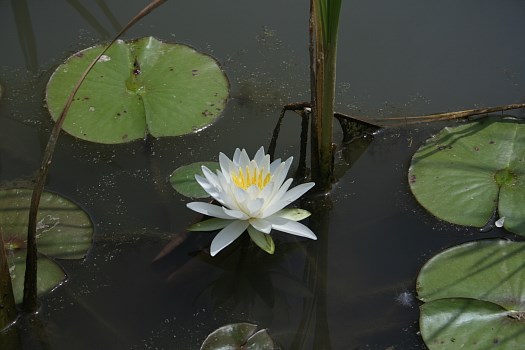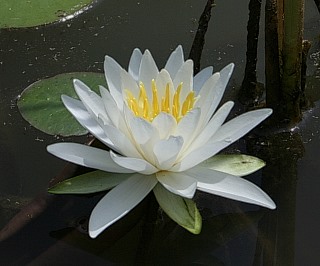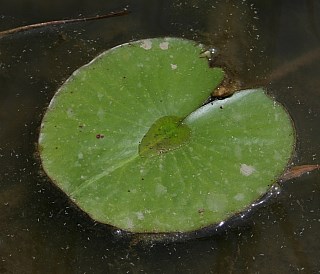Description: This perennial plant is a floating aquatic that can grow in water up to 8' deep. The leaves develop directly from the rootstock on long petioles. They are 4-12" across, orbicular in shape, cleft toward the middle on one side, and smooth along the outer margins. The upper surface of the leaf is medium green, while the lower surface is often purplish; its texture is rather leathery and thick. Fine veins radiate outward from the center of the leaf. The air pores through which the leaf breathes are located on the upper surface, rather than the lower surface (unlike the leaves of most plants). The long petiole of each leaf is terete, stout, and purplish; it is often covered with algae.

Long flowering
stalks also develop directly from the rootstock; each stalk is
unbranched and bears a single floating flower at its apex. The
appearance of these stalks resembles the petioles of the leaves. Each
flower is about 3-6" across; it has 4 greenish white sepals on the
bottom that rest on the water surface, and about 20-30 white petals
above. In the middle of the petals, there are many golden yellow
stamens surrounding a single pistil. The petals are elliptic-lanceolate
and they curve slightly upward. The outer stamens have winged filaments
that are broader than the anthers, while the inner stamens have narrow
filaments. The blooming period occurs during the summer and early fall.
Each flower lasts only 3-4 days; it opens up during the morning and
closes during the afternoon. The flowers are quite fragrant. After the
petals wither away, a multicelled fruit develops that is globoid; the
stalk of this fruit bends downward and it matures underwater.
Eventually, this fruit releases its seeds which float upward to the
surface of the water. After being carried about by water currents and
the wind, they sink downward to the bottom, where they can germinate.
The root system consists of long forking rhizomes and coarse fibrous roots. Vegetative colonies are often formed.
roots. Vegetative colonies are often formed.
Cultivation:
The preference is clear water up to 8' deep, sunny conditions on the
water surface, and mucky soil to anchor and nourish the root system.
The water should be still or slow-moving with little exposure to high
wind or waves. Fragrant Water Lily appears to favor water that is
somewhat acidic, rather than calcareous and alkaline. It is able to
survive quite cold winters.
Range & Habitat:
While the entire state falls within the range of Fragrant Water Lily in
the United States, it is a rare native plant that is found in only a
few
counties in NE and southern Illinois (see Distribution
Map). This water lily is absent from natural habitats in the
central area of the state, although it is sometimes cultivated in ponds
and wetland gardens. Natural habitats include ponds, protected areas of
lakes, and clear slow-moving rivers, particularly where dams have been
constructed (whether by humans or beavers).
Faunal Associations:
The abundant pollen of the flowers attracts small bees (mainly
Halictid), various flies, and beetles. In particular, the bees Hylaeus
nelumbonis, Lasioglossum nelumbonis, and Lasioglossum
nymphaearum are oligoleges (specialist visitors) of the
flowers of water lilies and closely related plants. There are also
oligolectic insects that feed on the leaves and petioles of water
lilies. These include Sericothrips langei
(Waterlily Thrips) and the larvae of several moths, including Bellura
gortynoides (White-Tailed Diver), Monroessa gyralis
(Pyralid Moth sp.), and Synclita obliteralis (Water
Lily Leafcutter). The larvae of Galerucella nymphaeae
(Water Lily Beetle) and several Donacia spp. (Water
Lily Leaf Beetles) feed on water lilies; the adults feed on either the
pollen or the leaves. In the Midwest, water lilies have only minor food
value to ducks, which feed on the rootstocks and fruits/seeds primarily
in the Gulf states. Various
turtles also feed on the leaves, petioles, and fruits/seeds of water
lilies, including Chelydra serpentina (Snapping
Turtle), Chrysemys picta marginata (Midwestern
Painted Turtle), and Sternotherus odoratus (Musk
Turtle). The foliage and rootstocks are favorite sources of food for
muskrats and beavers. White-Tailed Deer occasionally enter the water to
feed on the foliage of water lilies.
adults feed on either the
pollen or the leaves. In the Midwest, water lilies have only minor food
value to ducks, which feed on the rootstocks and fruits/seeds primarily
in the Gulf states. Various
turtles also feed on the leaves, petioles, and fruits/seeds of water
lilies, including Chelydra serpentina (Snapping
Turtle), Chrysemys picta marginata (Midwestern
Painted Turtle), and Sternotherus odoratus (Musk
Turtle). The foliage and rootstocks are favorite sources of food for
muskrats and beavers. White-Tailed Deer occasionally enter the water to
feed on the foliage of water lilies.
Photographic Location:
A pond in a park that is maintained by the University of Illinois in
Urbana, Illinois.
Comments:
This water lily has spectacular fragrant flowers. The leaf pads are
also attractive, but they can appear rather beat-up toward the end of
the growing season. Fragrant Water Lily is very similar to Nymphaea
tuberosa (White Water Lily), which is more common in
Illinois. This latter species has slightly larger flowers (about 4-8"
across) that are lacking in significant fragrance. Also, the petals of
its flowers are more blunt at their tips than those of the Fragrant
Water Lily. The seeds of White Water Lily are larger in size (3-4 mm.
in length and ovoid-globoid in shape) than the seeds of Fragrant Water
Lily (2 mm. in length and ellipsoid-oblongoid in shape). Other floating
aquatic plants that are somewhat similar to water lilies include Nuphar
advena (Spatterdock), Nelumbo lutea
(Water Lotus), and Brasenia schreberi
(Watershield). The flowers of these plants are either yellow or reddish
purple, and they are all native to Illinois.